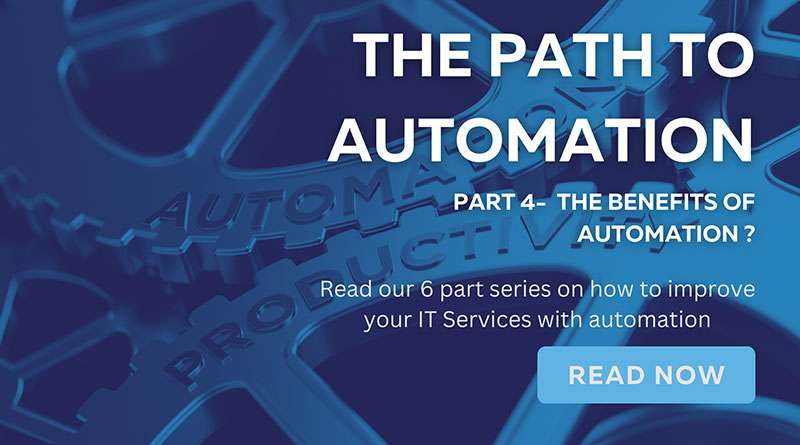The Path to Automation, part 4: Is time saved the only consideration?
Time saved is nearly always the most important factor when it comes to the benefits of automation. However, it is not the only factor.
In a simple world, you’d pull a report of all the tickets that are logged, find the most time-consuming item, automate it, and then move onto the next one down the list. But, of course, things are rarely this straightforward and other considerations have to come into play.
Here are a few of the major factors to be aware of:
Overall business impact
This is the second biggest factor to consider. It’s all well and good adding value by implementing new initiatives but if your business is not delivering its core products or services, nothing else matters.
Let’s go back to an example in the previous article[link to article 2]. You may have calculated that automating password resets won’t save you the most time, so you’ve chosen to prioritise another request. However, this could leave your customers unable to reset their passwords outside of regular business hours, and being locked out of your systems could, for example, cause disruption to the sales team and affect business performance.
In such a scenario, the smart option would be to prioritise password resets after all, as it has a direct impact on your business’s ability to deliver its core services.
Budget
This is generally a straightforward call: if you don’t require additional budget, great – go ahead; if you do need more budget, then drop it for something else and wait until you have the available funds.
The only other key decision is when you need to make the decision between focusing the budget on a single automation opportunity versus the opportunity to automate multiple requests. Here, you’ll need to assess the options and pick the one that will offer the best return overall.
Customer satisfaction
Depending on who you ask in your business, this will either be the most or the least important consideration. One side of the argument states that customer satisfaction should drive the decisions you make, whereas the other side may be happy to ignore customer input and drive decisions based on time saved.
The correct stance here sits directly in the middle and can be slightly shifted on a case-by-case basis. To the side that argues customer satisfaction is all that matters: good luck providing a great service when all your agents are snowed under with repetitive tasks. And to the side that wants to ignore the customers: good luck providing a really efficient service to, well… no one.
That may be a tad extreme, but you get the point. You should always consider customer satisfaction, but it can never be the only consideration.
Automation potential
You need to look at this from a couple of different angles. Firstly, it needs to be technically possible to automate the task. Secondly, it needs to be practically possible to automate it too.
These days, you’ll struggle to find something that you technically can’t automate as every system less than 20 years old is built to allow automation. However, if you do come across something that’s absolutely impossible to automate, then you have no choice but to work with it, of course.
It’s more likely that something will not be practically possible, and this needs greater consideration. Let’s take an HR team, by way of example. They will be responsible for a huge number of highly sensitive and complex issues, such as disciplinary or sickness processes. Those events need human interaction throughout and it would often not be a good idea to automate them. Your best option in such cases is to ensure they are as efficient as possible and do not require any unnecessary effort.
Once you’ve factored in these additional considerations, the important thing to bear in mind is that it’s now a question of priorities. You may also need to explain to colleagues that it’s rarely a case of refusing to automate a particular process, it’s more a question of working through them in the order that provides the most benefit for the organisation as a whole.
Then once you’ve picked your top priority for automation, your next steps are crucial. Click here to read the next article in our series.
This is part 4 in our series of articles about automation. To start at the beginning, click here.
We hope you’ve found this useful. If you do, please get in touch for a no-strings chat about how we can help your organisation reap the benefits of automation.



